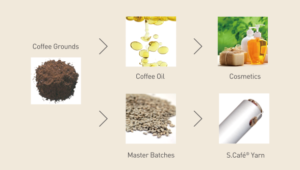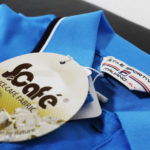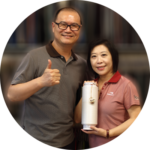 This is a story of textile, inspiration and… coffee. The story starts in Taiwan few years ago, when Jason Chen was with his wife Amy out enjoying a local performance. While taking a break and sipping on a cup of coffee at a coffee shop, Jason and Amy saw a person coming into the shop asking for used coffee ground to take home. Upon seeing this, Amy jokingly told Jason that because he enjoys sports so much and often stinks of sweat should put coffee ground in his clothes so he would be less of a “smelly man”… Maybe not everyone could know it, but coffee grounds have a unique deodorizing function, so Jason after hearing his wife’s wisecrack thought for a moment, then turned to his wife and yelled “Good idea”! If one can harness the ability to incorporate coffee grounds to make clothes, one can also increase the performance and value of this sustainable product. Jason quickly gathered a group of innovators and environmental partners and began researching the possibilities of inputting coffee grounds into yarn. Finally, after four years of research, development, blood, sweat, and tears… Jason has done it. In 2009 S.Café® brand was created with more products and innovations to come following this main concept. S.Café® is one of the several brands born from this idea, patented by Singtex textile company and since is development it has been used by a lot of garment companies all over the world. The last one is Fila, the sport clothes company that decided to use this kind of fiber to produce a polo shirt dedicated to Italy and in particular to Biella, the place where the historic brand was born more than forty years ago.
This is a story of textile, inspiration and… coffee. The story starts in Taiwan few years ago, when Jason Chen was with his wife Amy out enjoying a local performance. While taking a break and sipping on a cup of coffee at a coffee shop, Jason and Amy saw a person coming into the shop asking for used coffee ground to take home. Upon seeing this, Amy jokingly told Jason that because he enjoys sports so much and often stinks of sweat should put coffee ground in his clothes so he would be less of a “smelly man”… Maybe not everyone could know it, but coffee grounds have a unique deodorizing function, so Jason after hearing his wife’s wisecrack thought for a moment, then turned to his wife and yelled “Good idea”! If one can harness the ability to incorporate coffee grounds to make clothes, one can also increase the performance and value of this sustainable product. Jason quickly gathered a group of innovators and environmental partners and began researching the possibilities of inputting coffee grounds into yarn. Finally, after four years of research, development, blood, sweat, and tears… Jason has done it. In 2009 S.Café® brand was created with more products and innovations to come following this main concept. S.Café® is one of the several brands born from this idea, patented by Singtex textile company and since is development it has been used by a lot of garment companies all over the world. The last one is Fila, the sport clothes company that decided to use this kind of fiber to produce a polo shirt dedicated to Italy and in particular to Biella, the place where the historic brand was born more than forty years ago. One interesting thing about S.Café® is the sustainability aspect. Huge quantities of coffee grounds are created daily by coffee drinking. In Taiwan, that has a population of 23 million people, statistics shows that six million cups of coffee are consumed everyday, creating about 30 tons of coffee grounds and this data climb up 4,5 times per year. Estimates say that there are more that one billion coffee lovers around the world, who consume 1.6 billions cups of coffee in total per day. Coffee grounds can be used in many ways, like plant fertilizer and room deodorizers. The idea to use them in textile is another, innovative way to recycle them.
One interesting thing about S.Café® is the sustainability aspect. Huge quantities of coffee grounds are created daily by coffee drinking. In Taiwan, that has a population of 23 million people, statistics shows that six million cups of coffee are consumed everyday, creating about 30 tons of coffee grounds and this data climb up 4,5 times per year. Estimates say that there are more that one billion coffee lovers around the world, who consume 1.6 billions cups of coffee in total per day. Coffee grounds can be used in many ways, like plant fertilizer and room deodorizers. The idea to use them in textile is another, innovative way to recycle them.
Café® technology
Café® technology, with a low-temperature, high-pressure and energy saving process, combines coffee grounds onto the yarn surface, changing the characteristics of the filament, and offers up to 200% faster drying time compared to cotton. Moreover, the micro-pores on S. Café® coffee grounds absorb odors and reflect UV rays. So, starting from one feature of coffee grounds, Singtex team discovered other properties: coffee adds to fibers breathability, protection from sun and cooling of skin. Where does the odors absorbing feature come from? Roasting is the answer. When roasted, the coffee bean swells, which means that the space inside the bean expands.

During brewing, hot water removes materials that are clogging up the spaces, then finally the patented S.Café® process maximizes the functional performance capacity of the coffee ground. Comparing to cotton, S.Café® sustainable technology provides three times more odor control and this characteristic doesn’t disappear washing after washing because coffee grounds are embedded inside the yarns. Tests proved that S.Café® continually moves moisture away from the skin to the outer surface of the fabric for a faster drying process, improving its efficiency by 50% compared to other common used fabrics. Moreover, coffee grounds come with numerous microscopic pores, which create a long-lasting natural and chemical free shield for yarn or fiber, reflecting UV rays and provide a comfortable outdoor experience. Compared to cotton, S.Café® sustainable technology provides five more times UV protection. And the special S.Café ICE-CAFÉ™ yarn is able to cool down the temperature of the skin of one to two grades.
Produtcs for many uses
The fibers that allow this process are polymer, that with a low-temperature, high-pressure and energy saving process, combines coffee grounds onto the yarn surface, changing the features of the filament. Practically, three cups of coffee and five PET bottles are what a piece of coffee yarn clothing needs to be produced. Singtex collaborates with several famous coffee chain stores, recycling about 500 tons of coffee grounds everyday. Singtex has obtained several eco-friendly certifications: Bluesign2019, Cradle to Cradle, USDA-Biobased Product, Oeketex, GRS (Global Recycle Standard), SGS and others. The patented manufacturing process extracts from grounds a high concentration of essential coffee oil. This oil can then be re-used in textiles and also be used in cosmetics. P4DRY™ is a technology born from this process, it is a print layer that has three functions: quick-drying touch, odor control and reduction of condensation rate. It won prestigious awards from 2013 Outdoor Trade Fair in Germany, to 2014 Taiwan Excellence Award. Another product is AIRNEST™ bio-foam that can be used in fabrics production but also in shoes and many other ways. With natural wood pulp and S.Café® high-tech functional powder, “sefia™” is an all-natural green artificial fibers that can be decomposed by microorganisms so it can be converted into cellulose again. Sefia™ has the properties of high tenacity and stability, great moisture absorption, excellent drape, brilliant luster and biodegradability. AIRMEM™, the latest S.Café® innovation, is a new biobased coffee membrane that contains 25% of coffee oil extracted from spent coffee grounds; it is wind proof, water resistant and breathable. The claim of the company is “Drink it, wear it” and it is a good way to communicate the principles of sustainability or the three “R” of environment: recycle, reduce and reuse. This is the proof that textile is a fertile ground where to disseminate and test these values and that creativity and research can lead to very interesting outputs.
by Debora Ferrero




